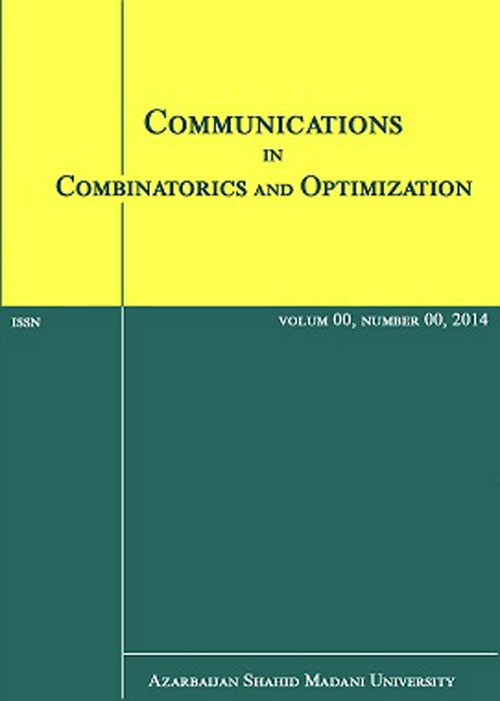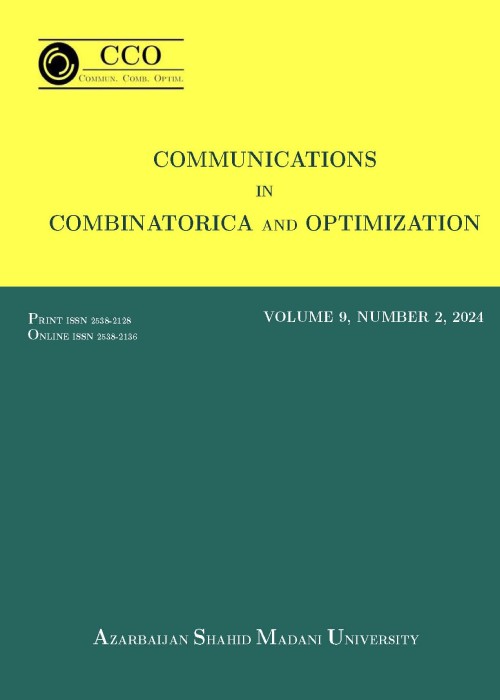فهرست مطالب

Communications in Combinatorics and Optimization
Volume:5 Issue: 1, Winter and Spring 2020
- تاریخ انتشار: 1398/09/24
- تعداد عناوین: 8
-
-
Pages 1-8
Let $G=(V,E)$, $V={1,2,ldots,n}$, $E={e_1,e_2,ldots,e_m}$,be a simple connected graph, with sequence of vertex degrees$Delta =d_1geq d_2geqcdotsgeq d_n=delta >0$ and Laplacian eigenvalues$mu_1geq mu_2geqcdotsgeqmu_{n-1}>mu_n=0$. Denote by $Kf(G)=nsum_{i=1}^{n-1}frac{1}{mu_i}$ and $t=t(G)=frac 1n prod_{i=1}^{n-1} mu_i$ the Kirchhoff index and number of spanning trees of $G$, respectively. In this paper we determine several lower bounds for $Kf(G)$ depending on $t(G)$ and some of the graph parameters $n$, $m$, or $Delta$.
Keywords: Topological indices, Kirchhoff index, spanning tree -
Pages 9-17
In a graph G, the first and second degrees of a vertex v is equal to thenumber of their first and second neighbors and are denoted by d(v/G) andd 2 (v/G), respectively. The first, second and third leap Zagreb indices are thesum of squares of second degrees of vertices of G, the sum of products of second degrees of pairs of adjacent vertices in G and the sum of products of firstand second degrees of vertices of G, respectively. In this paper, we initiate in studying a new class of graphs depending on the relationship between firstand second degrees of vertices and is so-called a leap graph. Some propertiesof the leap graphs are presented. All leap trees and {C 3, C 4 }-free leap graphsare characterized.
Keywords: Distance-degrees (of vertices), leap Zagreb indices, leap graphs -
Pages 19-26
Roman dominating function} on a digraph $D$ with vertex set $V(D)$ is a labeling$fcolon V(D)to {0, 1, 2}$such that every vertex with label $0$ has an in-neighbor with label $2$. A set ${f_1,f_2,ldots,f_d}$ ofRoman dominating functions on $D$ with the property that $sum_{i=1}^d f_i(v)le 2$ for each $vin V(D)$,is called a {em Roman dominating family} (of functions) on $D$. The maximum number of functions in aRoman dominating family on $D$ is the {em Roman domatic number} of $D$, denoted by $d_{R}(D)$.In this note, we study the Roman domatic number in digraphs, and we present some sharpbounds for $d_{R}(D)$. In addition, we determine the Roman domatic number of some digraphs.Some of our results are extensions of well-known properties of the Roman domatic number ofundirected graphs.
Keywords: Digraphs, Roman dominating function, Roman domination number, Roman domatic number -
Pages 27-39
Let $G$ be a simple graph with vertex set $V$. A double Roman dominating function (DRDF) on $G$ is a function $f:Vrightarrow{0,1,2,3}$ satisfying that if $f(v)=0$, then the vertex $v$ must be adjacent to at least two vertices assigned $2$ or one vertex assigned $3$ under $f$, whereas if $f(v)=1$, then the vertex $v$ must be adjacent to at least one vertex assigned $2$ or $3$. The weight of a DRDF $f$ is the sum $sum_{vin V}f(v)$. A total double Roman dominating function (TDRDF) on a graph $G$ with no isolated vertex is a DRDF $f$ on $G$ with the additional property that the subgraph of $G$ induced by the set ${vin V:f(v)ne0}$ has no isolated vertices. The total double Roman domination number $gamma_{tdR}(G)$ is the minimum weight of a TDRDF on $G$. In this paper, we give several relations between the total double Roman domination number of a graph and other domination parameters and we determine the total double Roman domination number of some classes of graphs.
Keywords: total double Roman domination, double Roman domination, total Roman domination, total domination, domination -
Pages 41-54
In this paper, we study both concepts of geodetic dominatingand edge geodetic dominating sets and derive some tight upper bounds onthe edge geodetic and the edge geodetic domination numbers. We also obtainattainable upper bounds on the maximum number of elements in a partitionof a vertex set of a connected graph into geodetic sets, edge geodetic sets,geodetic dominating sets and edge geodetic dominating sets, respectively.
Keywords: domination number, (edge) geodetic number, (edge) geodetic domination number -
Pages 55-60
The topological ordering algorithm sorts nodes of a directed graph such that the order of the tail of each arc is lower than the order of its head. In this paper, we introduce the notion of covering between nodes of a directed graph. Then, we apply the topological orderingalgorithm on graphs containing the covering nodes. We show that there exists a cut set withforward arcs in these graphs and the order of the covering nodes is successive.
Keywords: Directed graph, covering nodes, topological ordering algorithm -
Pages 61-68
If G = (V, E, σ) is a finite signed graph, a function f : V → {−1, 0, 1} is a minusdominating function (MDF) of G if f(u) +summation over all vertices v∈N(u) of σ(uv)f(v) ≥ 1 for all u ∈ V . In this paper we characterize signed paths and cycles admitting an MDF.
Keywords: signed graphs, minus domination, minus dominating function -
Pages 69-81
Let $x$ and $y$ be two distinct vertices in a connected graph $G$. The $x,y$-location of a vertex $w$ is the ordered pair of distances from $w$ to $x$ and $y$, that is, the ordered pair $(d(x,w), d(y,w))$. A set of vertices $W$ in $G$ is $x,y$-located if any two vertices in $W$ have distinct $x,y$-location.A set $W$ of vertices in $G$ is 2-located if it is $x,y$-located, for some distinct vertices $x$ and $y$. The 2-dimension of $G$ is the order of a largest set that is 2-located in $G$. Note that this notion is related to the metric dimension of a graph, but not identical to it.We study in depth the trees $T$ that have a 2-locating set, that is, have 2-dimension equal to the order of $T$. Using these results, we have a nice characterization of the 2-dimension of arbitrary trees.
Keywords: resolvability, location number, 2-dimension, tree, 2-locating set


